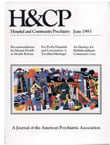A Comparison of Physically Aggressive Behavior in Two VA Nursing Homes
Abstract
Objective: To investigate an apparent difference in the prevalence of physically aggressive behavior in two Veterans Affairs (VA) nursing homes, the authors compared ratings by nurses of residents' assaultive behaviors at the beginning and end of two six-month periods in 1987 and 1991. Methods: The prevalence of assaultive behavior in each of three diagnostic subgroups (neurologic, psychiatric, and medical) at nursing homes A and B was determined using standardized biannual ratings of patients' behavior. Chi square analysis was used to compare prevalence rates and to compare the proportions of nonaggressive patients who were rated as aggressive at the end of each six-month period. Results: Nursing homes A and B were significantly different in the proportions of patients in the three subgroups; facility A had a greater percentage of neurologic and psychiatric patients, and facility B had a greater percentage of medical patients. Both in 1987 and in 1991, the prevalence of assaultive behavior in nursing home A in all three diagnostic subgroups was higher than that in nursing home B, usually by a statistically significant margin. A significantly higher proportion of nursing home A residents in each subgroup who were rated as nonaggressive at the beginning of the two periods were rated as aggressive at the end of each period. Conclusions: Further studies are needed to learn whether the substantial difference in assaultive behavior resulted from intrinsic characteristics of the facilities' populations or from the qualities of their environments.
Access content
To read the fulltext, please use one of the options below to sign in or purchase access.- Personal login
- Institutional Login
- Sign in via OpenAthens
- Register for access
-
Please login/register if you wish to pair your device and check access availability.
Not a subscriber?
PsychiatryOnline subscription options offer access to the DSM-5 library, books, journals, CME, and patient resources. This all-in-one virtual library provides psychiatrists and mental health professionals with key resources for diagnosis, treatment, research, and professional development.
Need more help? PsychiatryOnline Customer Service may be reached by emailing [email protected] or by calling 800-368-5777 (in the U.S.) or 703-907-7322 (outside the U.S.).



